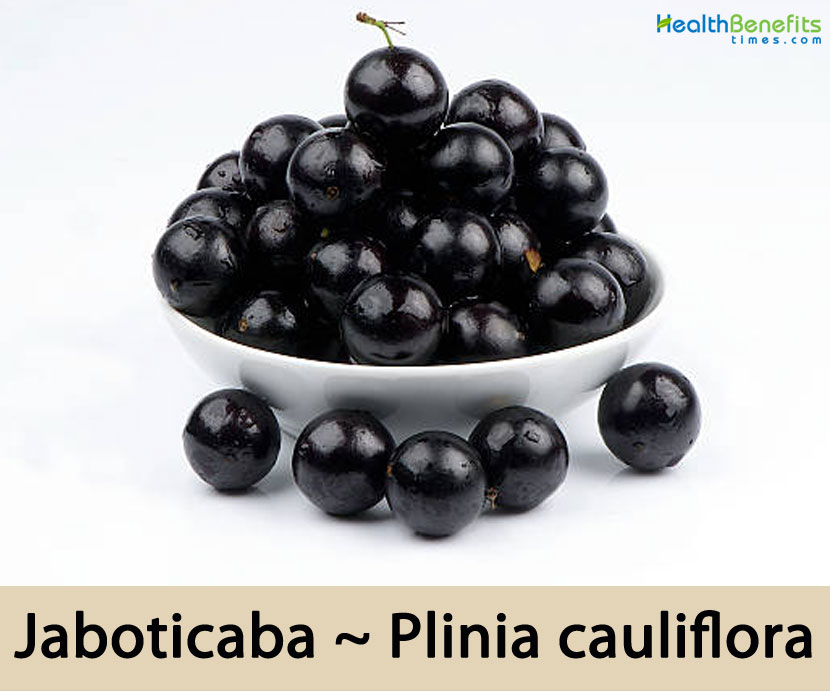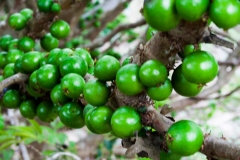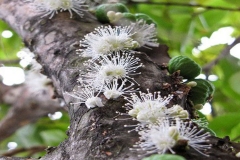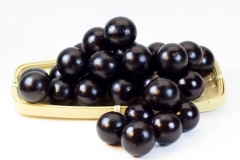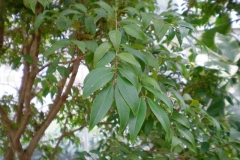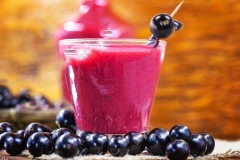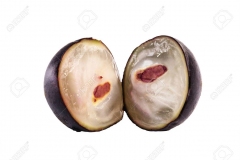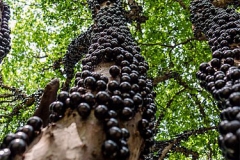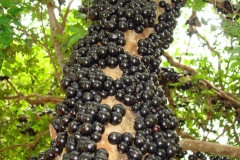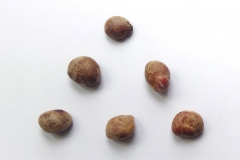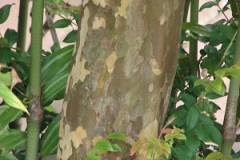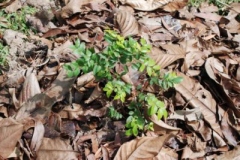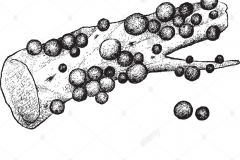| Jaboticaba Quick Facts | |
|---|---|
| Name: | Jaboticaba |
| Scientific Name: | Plinia cauliflora |
| Origin | Southern Brazil |
| Colors | Bright green when immature to dark purple or shiny black when fully ripe |
| Shapes | Globose to slightly oblate grape-like berries typically measures 1 inch in diameter |
| Flesh colors | White or rosy pink |
| Taste | Sharp, acidic taste |
| Health benefits | Sore Throat, Asthma, Weight Loss, Treatment to Diarrhea, Accelerate Healing Process, Skin benefits, Healthy hair, Anti-cancer properties, Digestive health, Reduce cardiovascular diseases, Diabetes, Goof for Liver, Against Early Aging, Inflammation in the throat, Increased Levels of Blood, Increased Levels of Blood, Relieves arthritis, Good for pregnant women |
| Name | Jaboticaba |
|---|---|
| Scientific Name | Plinia cauliflora |
| Native | Coastal forests and hilly regions of southern Brazil. It also grows around Rio de Janeiro and Minas Gerais, Brazil, also around Santa Cruz, Bolivia, Asunción, Paraguay, Uruguay and northeastern Argentina |
| Common Names | Guapuru, Taanumox, Ibapumi, Jabuticabeira, Jabuticaba, Jabuticabeira-preta, Jabuticabeira-rajada, Jabuticabeira-rosea, Jacoticaba de Sao Paulo, Grauda, jaboticabeira, Brazilian Grape, Brazilian Grapetree, Jaboticaba, Jabotica, jabotica, jabuticabeira, guaperu |
| Name in Other Languages | Afrikaans: Jaboticaba Albanian: Jaboticaba Amharic: Jaboticaba Arabic: Jabutikaba (جابوتيكابا), balinat jadheiat al’iizhar (بلينة جذعية الإزهار) Argentina : Iba-Purú Armenian: Jaboticaba Azerbaijani: Jabotikaba, Braziliya Üzüm Ağacı Bengali: Jaboticaba Bolivia : Guapurú Bosnian: Žabutikaba Brazil : Jaboticaba, Jaboticaba-De-Sabará, Jaboticaba Sabará, Jaboticabeira, Jabuticaba, Jabuticaba-Açu, Jabuticaba De Campinas, Jabuticaba-Murta, Jabuticaba-Paulista, Jabutica- Ponhema, Yabuticaba, sabará jaboticaba, guapuru, guaperu, hivapuru, ybapuru Bulgarian: Dzhabotikaba (джаботикаба), jabotikaba (жаботикаба) Burmese: Kabyaar (ကဗျာ) Catalan: Jabuticaba Chinese: Jiǎ bō tí kǎbā (贾波提卡巴) Croatian: Jaboticaba Czech: Jaboticaba Danish: Jaboticaba Dutch: Jaboticaba English: Jaboticaba, Brazilian grapetree, Black-fruited jaboticaba, Black jaboticaba, Brazilian grape tree, Jaboticaba, Jabuticaba, Guaperu, Guapuru, Hivapuru, Sabará, Ybapuru Esperanto: Jaboticaba Estonian: Jaboticaba Filipino: Jaboticaba Finnish: Jaboticaba, Brasilianrypälemyrtti French: Jaboticaba, Jaboticaba de Sao Paulo Georgian: Jaboticaba German: Jaboticaba Greek: Jaboticaba Guarani: Yvapurũ Gujarati: Jaboticaba Hausa: Jaboticaba Hebrew: ג’בוטיבה Hindi: Jaboticaba Hungarian: Jaboticaba Icelandic: Jaboticaba Indonesian: Jaboticaba Irish: Jaboticaba Italian: Jaboticaba Japanese: Jabochikaba (ジャボティカバ) Javanese: Jaboticaba Kannada: Jaboṭikābā (ಜಬೊಟಿಕಾಬಾ) Kazakh: Zhabotaba (жаботаба), Jabotikaba (Жаботикаба) Komi: Dzhabotikaba (Джаботикаба) Korean: Bo tika ba (bo 티카 바) Kurdish: Jaboticaba Lao: Jaboticaba Latin: Jaboticaba Latvian: Jaboticaba Lithuanian: Jaboticaba Macedonian: Jaboticaba, Jabutikaba (Жабутикаба) Malagasy: Jaboticaba jabuticaba-de-sabará Malay: Jaboticaba, Jabuticaba Malayalam: Jaboticaba, jabēāttikkāba (ജബോത്തിക്കാബ) Maltese: Jaboticaba Marathi: Jābōtībā (जाबोतीबा) Mongolian: Jabotikaba Nepali: Jaboticaba Norwegian: Jaboticaba Oriya: ଜାବୋଟିକାବା | Paraguay : Iba-Purú Pashto: Jaboticaba Persian: Jaboticaba, انگور برزیلی Polish: Jaboticaba Portuguese: Jaboticaba, Jabuticaba, jabuticaba-açu, jabuticaba-de-sabará, jabuticaba-murta, jabuticaba-paulista, jabuticabeira, Jaboticaba cabeira, Jaboticaba-de-cabinho, Jaboticaba murta, Jaboticaba olho-de-boi, Jaboticaba sabará, Jaboticabeira, Jabuticaba, Jabuticaba-açu, Jabuticaba-de-sabará, Jabuticaba-murta, Jabuticaba-paulista, Jabuticabeira, Jaboticatuba, Jaboticatuba grande Spanish: Guapurú, Iba-purú, Jaboticaba, Yabuticaba Punjabi: Jaboticaba Romanian: Jaboticaba Russian: Jabotikaba (жаботикаба) Serbian: Jaboticaba (Jаботицаба) Sindhi: Jabutiba (جبوتيبا) Sinhala: Jaboticaba Slovenian: Jaboticaba Spanish: Jaboticaba, Guapuru, Hivapuru, Iba-Puru, Sabara, Ybapuru, Yabuticaba. Sudanese: Jaboticaba Swedish: Jaboticaba, Stamjaboticaba Tajik: Jaboticaba Tamil: Jaboticaba Telugu: Jaboticaba Thai: Xngùn brāsil (องุ่นบราซิล) Turkish: Jabuticaba Ukrainian: Jaboticaba, Jabotikaba (Жаботикаба) Urdu: Jaboticaba Uzbek: Jabotikaba Vietnamese: Jaboticaba Welsh: Jaboticaba Zulu: Jaboticaba |
| Plant Growth Habit | Tropical, slow growing large, evergreen shrub or small, much branched, ornamental tree |
| Soil | Thrives best on deep, rich, moist, well drained, lightly acidic soil with a pH of 5.5–6.5 in full sun or partial shade, but can grow on calcareous (oolitic limestone) and sandy soils. The tree is not tolerant of salty or water-logged soils |
| Plant Size | About 5-13 m and trunk diameter of up to 20 cm |
| Bark | Bark is reddish brown, peeling to reveal a smooth, multicolored cream to gray under bark similar to guava |
| Leaf | Young foliage is salmon-pink in color. Young foliage and branchlets are hairy. Leaves are opposite, on very short, downy petioles, lanceolate to elliptic, 3–6.0 cm long by 1.5–2.5 cm wide, rounded at the base, sharply or bluntly pointed at the apex leathery, dark-green, and glossy |
| Flower | Flowers small, yellow-white, emerge from the multiple trunks, limbs and large branches in racemose clusters of four, on very short, thick pedicels, the flowers have 4 hairy, white petals and about 60 stamens to 4 mm long |
| Fruit Shape & Size | Globose to slightly oblate grape-like berries typically measures 1 inch in diameter |
| Fruit Color | Bright green when immature to dark purple or shiny black when fully ripe |
| Fruit Skin | Thick, purple, astringent skin |
| Flesh Color | Sweet, white or rosy pink gelatinous flesh |
| Seed | 1–3 small, slightly flattened seeds |
| Propagation | Grafted cuttings, layering, and seed |
| Lifespan | 150 years |
| Health Benefits |
|
| Taste | Sharp, acidic taste |
Plant Description
Jaboticaba is a tropical, evergreen shrub or small, much branched, ornamental tree. It is a slow growing tree that normally reaches a height of usually about 5-13 m and trunk diameter of up to 20 cm. The crown is rounding, symmetrical, dense, and wide. Bark is reddish brown, peeling to reveal a smooth, multicolored cream to gray under bark similar to guava. The tree prefers moist, rich, lightly acidic soil. It is extensively adjustable, however, and grows satisfactorily even on alkaline beach-sand type soils, so long as it is tended and irrigated. Its flowers are white and grow directly from its trunk in a cauliflorous habit. In an uncultivated state, the tree may flower and fruit only once or twice a year. When continuously irrigated it flowers frequently and fresh fruit can be available year-round in tropical regions.
Leaves
The tips of emerging foliage often have an attractive pink or reddish tint. The entire, simple, evergreen, opposite leaves, on very short, downy petioles are lanceolate or elliptic, rounded at the base, sharply or bluntly pointed at the apex. They are 1 to 4 in (2.5-10 cm) long and 1/2 to 3/4 in (1.25-2 cm) in width. They are salmon pink when young turning to leathery, dark-green, and glossy as they mature.
| Leaf arrangement | Opposite/sub opposite |
| Leaf type | Simple |
| Leaf margin | Entire |
| Leaf shape | Elliptic (oval) |
| Leaf venation | Pinnate; reticulate |
| Leaf type and persistence | Evergreen |
| Leaf blade length | Less than 2 inches |
| Leaf color | Green |
| Fall color | No fall color change |
| Fall characteristic | Not showy |
Flowers
Its flowers are small, staminous, white or near-white and cauliflorous, meaning they grow directly on the bark or underbark along the trunk, limbs and branches. This occurs several times a year primarily in late winter and spring. Rain and overhead irrigation are harmful to fruit set during the first 3 days after bloom. Two days after they appear, the flowers begin to wither.
| Flower color | White |
| Flower characteristic | Flowers periodically throughout the year |
Fruit
Fertile flowers are followed by globose to slightly oblate grape-like berries produced singly or in dense clusters from the ground up all over the trunk and main branches, and the plant may fruit up to five times per year. Fruits are not produced on new growth as is common on many other tropical fruit trees. Immature fruit is green and becomes dark maroon-purple to almost black when ripe. Fruit development is very rapid, usually 20 to 25 days from flower to full maturity. It is typically 1 inch in diameter, varying from 1/2 to 1 1/4 inches depending on species and variety. The edible berry consists of a whitish, soft, juicy, gelatinous pulp with 1 to 5 ovoid flattened seeds, with a resinous quality that is either delectable or quite disagreeable, depending upon personal taste. The skin is often compared to the thick-skinned Muscadine grape and has a somewhat turpentine flavor. The fruit is eaten fresh or made into jams and jellies, or used to make wine. Jaboticaba may take as many as eight years to bear fruit.
Common in Brazilian markets, jabuticabas are largely eaten fresh; their popularity has been compared to that of grapes in the United States. Fresh fruit may begin to ferment 3 to 4 days after harvest, so it is often used to make jams, tarts, strong wines, and liqueurs. Due to the short shelf-life, fresh jabuticaba fruit is rare in markets outside areas of cultivation.
| Fruit shape | Round |
| Fruit length | .5 to 1 inch |
| Fruit cover | Fleshy |
| Fruit color | Black |
| Fruit characteristic | Suited for human consumption |
Health benefits of Jaboticaba
Jaboticaba is used for the treatment for hemoptysis, asthma, diarrhea and dysentery also as a gargle for chronic inflammation of the tonsils are by the caustic decoction of the sun-dry skins is agreed in Brazil. Such use of fruit also may lead to excessive consumption of tannin. The fruit of Jaboticaba contain compounds similar to known to have positive biological effects in cranberries, grapes and other related species, including anti-ageing, anti-inflammatory and the antioxidant qualities. Listed below are some of the popular health benefits of Jaboticaba
1. Sore Throat
Locals have been using Jaboticaba as part of home remedy to treat sore throat since ancient time. The juice of Jaboticaba fruit is a bit sour, just like any types of berries. Mix the juice of Jaboticaba with warm water to help soothing the sore throat. Furthermore, the vitamin C found in Jaboticaba will help fighting infection in much effective way.
2. Asthma
It is true that asthma is among diseases that could be cured completely but it is possible to deal with the symptoms of asthma. Jaboticaba consists of some active compounds that could help opening up the bronchial airways which is very beneficial for asthma patients. Though this has been proven traditionally but still further studies are strongly required to support the claims.
3. Weight Loss
Since this fruit is very rare, only those who live in Brazil could enjoy this fruits as healthy snack during weight loss program that’s why you would not find it among the list of healthy fruits for weight loss. It is because this fruits are low in calories and carbohydrate but packed with vitamins, minerals and protein. Those combinations are excellent for weight loss.
4. Treatment to Diarrhea
As we all know that skin of Jaboticaba may cause constipation if you consume it too much. It is because it consists of specific compounds that could help slowing down the bowel movement. That’s why for medication purpose eating the Jaboticaba along with its skin is beneficial for treating diarrhea in natural way.
5. Accelerate Healing Process
There are some reasons why this fruit is highly recommended to consume during recovery or healing process. First, this fruit is packed with vitamin C which could act as immunity booster; second this fruit is super juice that could keep your body hydrated to optimize the body metabolism during recovery.
6. Skin benefits
Being one of the powerful antioxidants it prevent early aging and also in preventing the occurrence of ageing signs like dark spots, wrinkles and fine lines. This exotic fruit has important nutrients, particularly in its peel that has been found to be very beneficial for your skin. Studies have found that Jaboticaba helps in rejuvenating and hydrating your skin. It also encourages the production of collagen that helps in increasing the elasticity and suppleness of skin. The pulp of this fruit consists of vitamin B3 which supports the functioning of enzymes that encourage cell growth. It also has detoxifying and anti-microbial properties and hence is used in the treatment of acne. Jaboticaba is used in preparation of tropical skin care formulations. Jaboticaba pulp is mixed with oatmeal and honey to make Jaboticaba face scrub at home.
7. Healthy hair
Nutrients in Jaboticaba promote healthy and lustrous growth of hair and are also helpful in preventing hair loss. Various preparations with Jaboticaba extract for hair are also available in market.
8. Anti-cancer properties
Jaboticaba is very popular for its powerful antioxidant effects due to the presence of phenolic compounds like anthocyanins and many others. Anthocyanins, which act as potent antioxidants also possess anti-inflammatory, with anti-cancer properties. These antioxidants help in fighting off the free radicals that are responsible for causing cell damage and DNA mutations.
9. Digestive health
High fiber content in Jaboticaba helps in making your bowel movements regular and in preventing constipation. The nutrients in this fruit aid in digestion and also in cleansing and detoxifying your intestine.
10. Reduce cardiovascular diseases
It has been found that diets rich in anthocyanin or polyphenols can lower your risks of cardiovascular diseases by regulating lipid metabolism. Research conducted in obese rats confirmed that such diets help in reducing the total serum cholesterol and triglyceride levels and also in increasing the good cholesterol (HDL) levels. Jaboticaba peel is a rich source of dietary fiber that is capable of lowering the levels of LDL and total cholesterol.
11. Diabetes
According to research conducted on mice, the peel of Jaboticaba is effective in reducing blood glucose levels and therefore its regular consumption may be helpful in preventing type 2 diabetes. Since it a low calorie food with plenty of dietary fiber, it is a healthy addition to the diet of people with diabetes. Animal studies have also found out anti-obesity properties of Jaboticaba peel.
12. Goof for Liver
Jaboticaba juice has essential properties that help to make the stress of the liver also help to filter toxins in the liver while nourishing the body with vitamins and minerals.
13. Against Early Aging
Rich content of antioxidants present in Jaboticaba juice helps slow the aging process and helps neutralize old fine lines and blemishes.
14. Good for pregnant women
In olden times, Jaboticaba was given to pregnant women because of the high amounts of iron in it. This fruit is also a good source of folic acid that plays a major role in the growth and development of the baby.
15. Increased Levels of Blood
The Jaboticaba juice consists of large amounts of iron which helps increase blood levels in the body. Also, the iron present in Jaboticaba Juice helps in treating diseases related to low blood levels such as anemia, dizziness, and fainting.
16. Stronger bones and teeth
High levels of calcium, potassium and magnesium in this fruit is beneficial for your bones and teeth. These minerals help in strengthening your bones and in preventing conditions like osteoporosis.
17. Relieves arthritis
Because of its powerful anti-inflammatory properties, Jaboticaba is useful in easing arthritis and other inflammation related disorders.
Traditional Uses and benefits of Jaboticaba
- It is also used as a gargle for chronic inflammation of the tonsils.
- Traditionally in Brazil, an astringent decoction of the sun-dried skins has been used as a treatment for hemoptysis, asthma, diarrhea, dysentery and gargle for chronic inflammation of the tonsils.
- Its bark is commonly used against diarrhea and other disorders based on its astringency.
- Bark and leaves are used to treat diarrhea by the local people in a semi-arid Brazilian region.
- Jaboticaba fruits are consumed in the forms of juices, jams, liqueurs, distillates, wine, and ice cream, as an alternative to prevent post-harvesting losses.
Culinary Uses
- It is high in Vitamin C and can be eaten raw or processed first into sweets or fermented into wine.
- Fruit can be eaten raw, made into jellies, syrups and preserves or fermented into wine.
- The jam is marketed in Brazil as ‘Brazilian Grape Jelly’.
- It is used in jelly, or as a fine wine, or eaten out of hand.
- Ripe Jaboticaba fruits are highly nutritious and are mostly eaten as fresh fruit but are also processed to make juice, dry sweet wine, liquor, vinegar, sherbets, compotes, jam, jelly, tarts and marmalade.
- The fruits are often used for making jelly and marmalade, with the addition of pectin.
- It is also popularly squeezed to make a fresh juice or fermented to make wine and liqueurs.
Other Facts
- Wood is only used for charcoal and as fuel.
- The wood is straight-grained, average texture, moderately heavy, but susceptible to wood-eating organisms.
- Jaboticaba has become popular as bonsai plants in Taiwan and the Caribbean.
- Extracts used as natural dye in food coloring.
Precautions
- Attention should be given to excessive consumption of this decoction, which could lead to too much tannin in the body, which is carcinogenic if taken over a long period of time.
- The skin of Jaboticaba may cause you constipation, especially when you eat them in more than just moderate amount.
References:
https://www.itis.gov/servlet/SingleRpt/SingleRpt?search_topic=TSN&search_value=835279#null
https://npgsweb.ars-grin.gov/gringlobal/taxon/taxonomydetail?id=465344
https://pfaf.org/user/Plant.aspx?LatinName=Plinia+cauliflora
http://www.missouribotanicalgarden.org/PlantFinder/PlantFinderDetails.aspx?taxonid=302521
https://plants.usda.gov/core/profile?symbol=MYCA9
https://en.wikipedia.org/wiki/Jabuticaba
https://www.cabi.org/isc/datasheet/35524
https://davesgarden.com/guides/pf/go/61077/#b
https://gringlobal.irri.org/gringlobal/taxonomydetail.aspx?id=465344
http://www.theplantlist.org/tpl1.1/record/kew-161353
http://tropical.theferns.info/viewtropical.php?id=Plinia+cauliflora
https://www.growables.org/information/TropicalFruit/jaboticaba.htm
http://www.stuartxchange.com/Jaboticaba
https://www.deerfield-beach.com/DocumentCenter/View/13948/Jaboticaba—Factsheet?bidId=
https://gd.eppo.int/taxon/MYCCA


